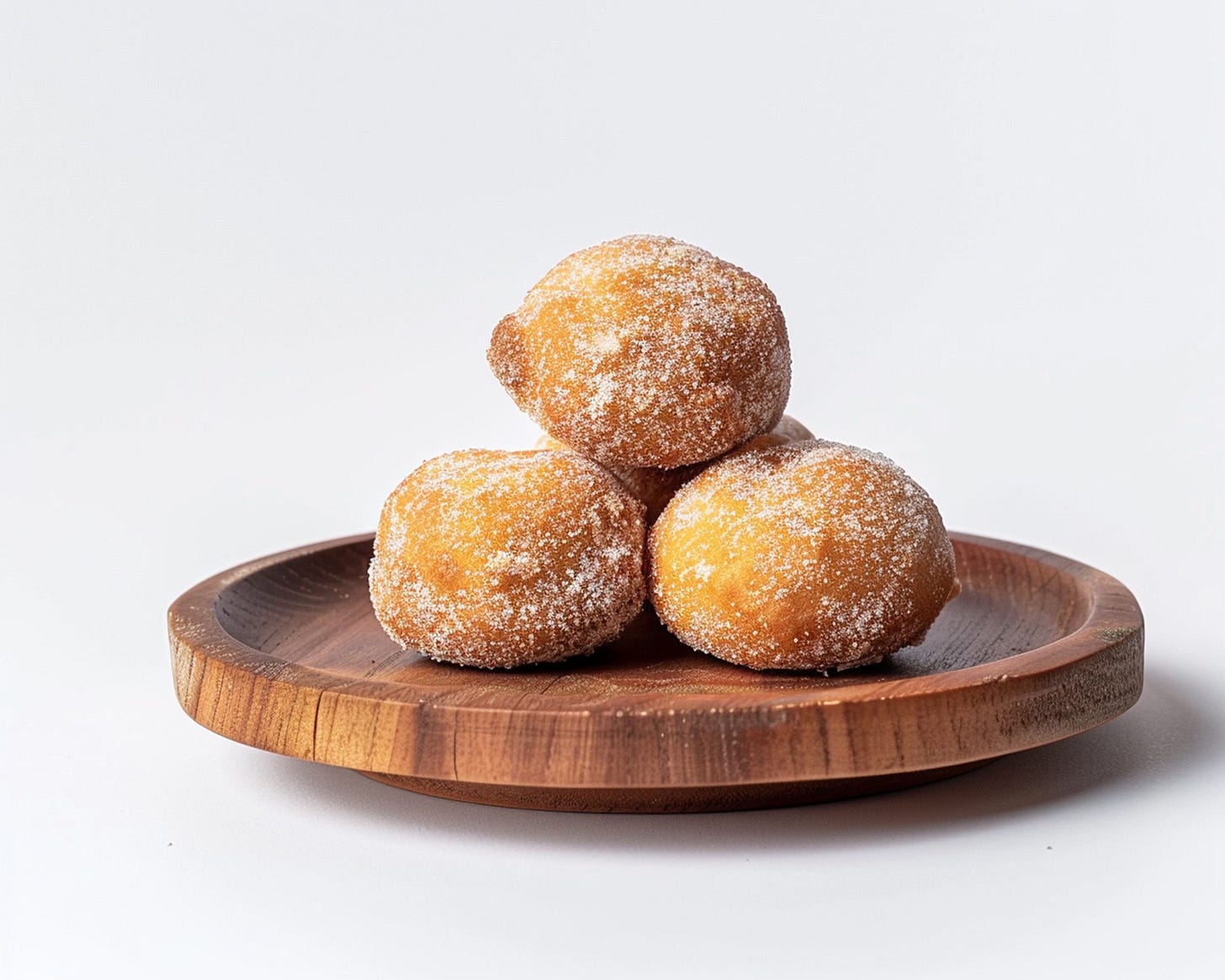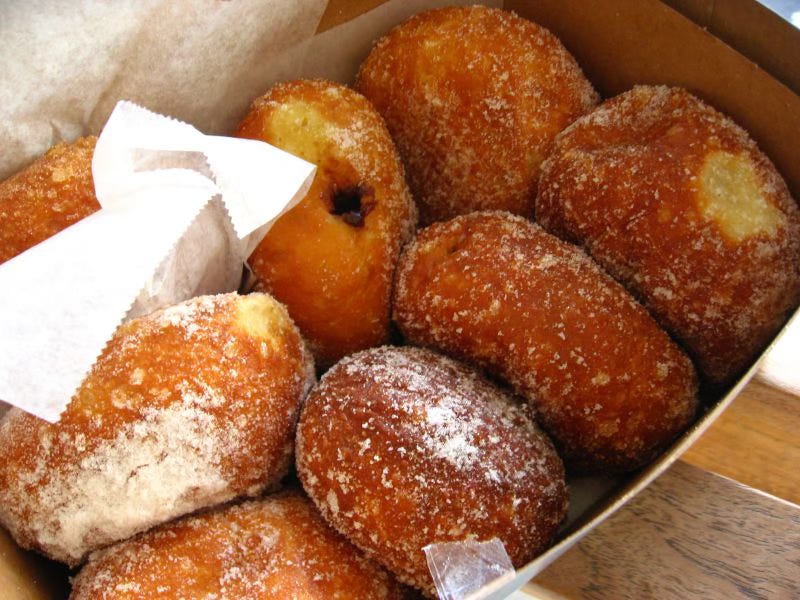Malasadas: the tale of the travelling fried balls (and how to make them)
Malassadas: a história dos bolinhos fritos viajantes (e como fazê-las)

[English version with recipe below.]
Malassadas: a história dos bolinhos fritos viajantes (e como fazê-las)
As malassadas são um doce tradicional português, especialmente popular nas ilhas da Madeira e dos Açores, mas muitas pessoas conhecem-nos como um doce do Havai. Têm uma longa história e fazem parte de muitas celebrações e tradições no mundo.
As malassadas têm origem na Madeira durante o auge das plantações de cana-de-açúcar no século XVI. A palavra "malassada" vem do português antigo e significa "mal cozido" ou "mal passado", referindo-se ao interior macio e ligeiramente cru da bola de massa. Feitas com ingredientes simples–farinha, açúcar, ovos, leite e fermento–a massa é preparada e deixada a levedar, moldada em pequenos círculos e frita em banha ou óleo até ficar dourada. Após a fritura, uma técnica que se diz ter vindo da ocupação moura, as malassadas são polvilhadas com açúcar, que pode ser simples ou misturado com canela.
Tradicionalmente, as malassadas eram feitas para celebrar a Terça-feira Gorda, o dia antes da Quaresma, período durante o qual muitos cristãos evitam comer alimentos ricos. Por isso, a Terça-feira Gorda era um momento especial para usar todos esses ingredientes ricos que, de outra forma, seriam desperdiçados.
No final do século XIX, muitos portugueses emigraram para outras partes do mundo, juntamente com as suas tradições culinárias. Foram para as Ilhas das Canárias, para os Açores, o Brasil, e para os Estados Unidos, especialmente no Havai, onde as malassadas tornaram-se muito populares.
Os trabalhadores portugueses que foram para o Havai para trabalhar nas plantações de açúcar introduziram as malassadas. Hoje, as malassadas são uma parte importante da culinária havaiana, com variações locais, e introduziram recheios tais como as natas, o coco, ou o chocolate. Este doce tornou-se tão popular no Havai que a Terça-feira Gorda é conhecida como “Malasada Day” (Dia da Malassada).
Em Portugal continental, existem doces semelhantes às malassadas, como os sonhos e as filhós. São especialmente populares durante o Natal e frequentemente aromatizadas com raspas de laranja ou limão e por vezes anis. Os sonhos são pequenos e leves, geralmente polvilhados com açúcar ou cobertos com um xarope doce.
Apesar destas variações, todas estas iguarias partilham uma característica comum: são doces fritos que trazem alegria e conforto. As malassadas, com a sua simplicidade e sabor delicioso, continuam a ser uma parte querida da cultura e das tradições portuguesas, representando a história e a cultura das ilhas da Madeira e dos Açores.
Que tal experimentá-las tu mesmo? Vê a receita das malassadas tradicionais abaixo. Mas antes, queres levar a tua leitura um passo adiante? Responde às perguntas abaixo ou usa as perguntas para discutir sobre o artigo com outra pessoa.
1. O que significa "malassada" em português antigo e porque é que se chama assim?
2. Quais são os ingredientes básicos usados para fazer malassadas?
3. Porque é que as malassadas eram tradicionalmente feitas na Terça-feira Gorda?
4. Como é conhecida a Terça-feira Gorda no Havai?
5. Compare e contraste as malassadas com os sonhos. Quais são as principais semelhanças e diferenças?
Receita de malassadas tradicionais
Ingredientes
(Faz 24 pequenas ou 12-16 grandes):
1 chávena de leite morno (110°F/45°C)
1 colher de sopa de fermento seco ativo
1/2 chávena de açúcar granulado
3 ovos grandes
1/2 chávena de manteiga, derretida e arrefecida
1 colher de chá de sal
4 chávenas de farinha para todos os fins (mais um extra para polvilhar)
Óleo vegetal para fritar
Açúcar granulado adicional ou açúcar com canela para a cobertura
Instruções:
1. Ativar o fermento:
Numa tigela pequena, mistura o leite morno e o fermento. Deixa repousar durante cerca de 5-10 minutos até ficar espumoso.
2. Preparar a massa:
Numa tigela grande, bate o açúcar, os ovos, a manteiga derretida e o sal.
Adiciona a mistura de fermento à tigela e mistura bem.
Adiciona gradualmente a farinha, uma chávena de cada vez, misturando bem após cada adição. A massa deve ser macia e ligeiramente pegajosa.
3. Deixar a massa crescer:
Cubre a tigela com um pano de cozinha limpo ou com película aderente.
Deixa a massa levedar num local quente e sem correntes de ar durante cerca de 1-2 horas, ou até duplicar de tamanho.
4. Dar forma à massa:
Depois de a massa ter crescido, dá-lhe um murro para libertar o ar.
Vira a massa para uma superfície ligeiramente enfarinhada.
Divide a massa em pequenas bolas, mais ou menos do tamanho de uma bola de golfe, e coloca-as num tabuleiro enfarinhado. Deixa-as repousar durante 10 a 15 minutos.
5. Fritar as Malassadas:
Numa frigideira grande e funda ou num forno holandês, aquece cerca de 2 polegadas de óleo vegetal a 175°C (350°F).
Aplana cuidadosamente cada bola de massa até formar um disco (as malassadas vão inchar quando forem fritas).
Frita algumas malassadas de cada vez, tendo o cuidado de não encher demasiado a frigideira. Frita durante cerca de 2-3 minutos de cada lado, ou até ficarem douradas e cozinhadas.
Utiliza uma escumadeira para retirar as malassadas do óleo e escorre-as em papel absorvente.
6. Cubra as malassadas:
Enquanto ainda estão quentes, enrola as malassadas em açúcar granulado ou açúcar com canela até ficarem bem revestidas.
7. Servir e saborear:
As malassadas são melhor apreciadas frescas e quentes. Serve-as como uma deliciosa guloseima ao pequeno-almoço ou à sobremesa.
Dicas:
Certifica-te de que o leite está morno, não quente, para ativar corretamente o fermento.
Ajusta o tempo de fritura com base na espessura da massa para garantir que ficam bem cozinhadas.
Para um toque extra, podes rechear as malassadas com creme, compota ou chocolate antes de as fritar.

Malasadas: the tale of the travelling fried balls
Malasadas are a traditional Portuguese sweet, especially popular on the islands of Madeira and the Azores, but many people know them as a Hawaiian sweet. They have a long history and are part of many celebrations and traditions around the world.
Malasadas originated in Madeira during the height of the sugar cane plantations in the 16th century. The word "malasada" comes from Old Portuguese and means "undercooked" or "underdone", referring to the soft, slightly raw interior of the dough ball. Made with simple ingredients - flour, sugar, eggs, milk and yeast - the dough is prepared and left to rise, moulded into small circles and fried in lard or oil until golden brown. After frying, a technique said to have come from the Moorish occupation, the malasadas are sprinkled with sugar, which can be plain or mixed with cinnamon.
Traditionally, malasadas were made to celebrate Shrove Tuesday, the day before Lent, a period during which many Christians avoid eating rich foods. So Shrove Tuesday was a special time to use up all those rich ingredients that would otherwise go to waste.
At the end of the 19th century, many Portuguese emigrated to other parts of the world, along with their culinary traditions. They went to the Canary Islands, the Azores, Brazil and the United States, especially Hawaii, where malasadas became very popular.
The Portuguese labourers who went to Hawaii to work on the sugar plantations introduced the malasadas. Today, malasadas are an important part of Hawaiian cuisine, with local variations, and introduced fillings such as cream, coconut or chocolate. This sweet has become so popular in Hawaii that Shrove Tuesday is known as "Malasada Day".
In mainland Portugal, there are sweets similar to malasadas, such as sonhos and filhós. They are especially popular at Christmas and are often flavoured with orange or lemon zest and sometimes aniseed. Sonhos are small and light, usually sprinkled with sugar or covered in a sweet syrup.
Despite these variations, all these delicacies share a common characteristic: they are fried sweets that bring joy and comfort. Malasadas, with their simplicity and delicious flavour, remain a beloved part of Portuguese culture and traditions, representing the history and culture of the islands of Madeira and the Azores.
How about trying them yourself? Check out the recipe for traditional malasadas below. But before, want to take your reading one step further? Answer the questions below or use the questions to discuss the article with someone else.
1. What does "malasada" mean in Old Portuguese, and why is it called that?
2. What are the basic ingredients used to make malasadas?
3. Why were malasadas traditionally made on Shrove Tuesday?
4. What is Shrove Tuesday known as in Hawaii?
5. Compare and contrast malasadas with sonhos. What are the main similarities and differences?
Traditional malasadas recipe
Ingredients:
(makes 24 small or 12-16 large)
1 cup warm milk (45°C/110°F)
1 tablespoon active dry yeast
1/2 cup granulated sugar
3 large eggs
1/2 cup butter, melted and cooled
1 teaspoon salt
4 cups all-purpose flour (plus extra for dusting)
Vegetable oil for frying
Additional granulated sugar or cinnamon sugar for coating
Instructions:
Activate the Yeast:
In a small bowl, combine the warm milk and yeast. Let it sit for about 5-10 minutes until frothy.
Prepare the Dough:
In a large mixing bowl, whisk together the sugar, eggs, melted butter, and salt.
Add the yeast mixture to the bowl and mix well.
Gradually add the flour, one cup at a time, mixing thoroughly after each addition. The dough should be soft and slightly sticky.
Let the Dough Rise:
Cover the bowl with a clean kitchen towel or plastic wrap.
Let the dough rise in a warm, draft-free place for about 1-2 hours, or until it has doubled in size.
Shape the Dough:
Once the dough has risen, punch it down to release the air.
Turn the dough out onto a lightly floured surface.
Divide the dough into small balls, about the size of a golf ball, and place them on a floured baking sheet. Let them rest for 10-15 minutes.
Fry the Malassadas:
In a large, deep frying pan or Dutch oven, heat about 2 inches of vegetable oil to 350°F (175°C).
Carefully flatten each ball of dough into a disk (they will puff up when fried).
Fry a few malasadas at a time, being careful not to overcrowd the pan. Fry for about 2-3 minutes on each side, or until golden brown and cooked through.
Use a slotted spoon to remove the malasadas from the oil and drain them on paper towels.
Coat the Malasadas:
While still warm, roll the malassadas in granulated sugar or cinnamon sugar until well coated.
Serve and Enjoy:
Malassadas are best enjoyed fresh and warm. Serve them as a delightful treat for breakfast or dessert.
Tips:
Ensure the milk is warm, not hot, to properly activate the yeast.
Adjust the frying time based on the thickness of the dough to ensure they are cooked through.
For an extra touch, you can fill the malasadas with custard, jam, or chocolate before frying.



